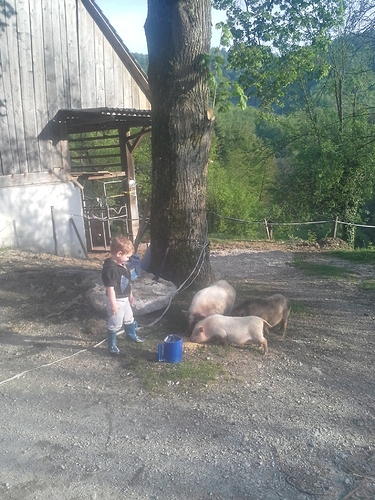Oil covered corn cobs would suggest a raw wood gasifier as well. Maybe they mean coal?
I don’t get where the smoke comes from. I know my charcoal lawn mower will drive you out of the shop on gasoline but is very tolerable on charcoal.
I think they should check their sources… 
Most probably its just a raw wood gasifier with open top…
@David, my first gasifier ever was based on coal… never seen smoke, but the smell… delicious… same as the browncoal in eastern germany…
Sounds like a good dose of propaganda written into that article. Funny how the more a person may know about actual events or technical details the less the news reports resemble truth.
I believe it has been posted in threads here before that the North Koreans have been using chunk wood fueled gasifiers for a long time due to scarcity of petroleum. Even the writer of the article contradicts the charcoal claim by referring to the cutting of wood as a direct fuel source, or corn cobs sprayed with used motor oil or possibly used vegetable oil (sounds like a great idea)…
And of course charcoal won’t smoke. And neither would any gasifier in operation except at the normal times of start up or refueling. So at best the writer went on a flight of fancy, obviously not based on reliable or first hand information.
It makes sense that the traffic control exempts the wood powered vehicles of road tolls, “fines”, as the author says… another good idea.
So from the little bit that can be trusted from the article, the North Koreans are short enough of oil that wood gasification is an economically viable option. They also have a ready built heavy vehicle fleet to be able to respond.
I doubt any other country would be able to respond so effectively. Good for them, sounds like a positive development for the planet, and their population who no doubt rely on transportation. It would be very enlightening to know what technical developments they are no doubt making, and the practical experience and economics of operation. That would be an interesting news article.
This is just a reminder for those of you who haven’t looked at_Suspicious Observers.
You can call it a weather station. Considering the loss of wheat and calves, it is an important resource,. This isn’t an attempt to prolong a locked thread.
Here is another excelent weather site more focused on off-shore weather. I’ve followed it for years,
I showed this article to my wife and told her to be real nice to me while we are chunking wood 
A few more events like this and I’m sure there are a measure of people that would want to ban wood chippers and chunkers 
My uncle who used to work as a butcher slaughtered one of those pot bellied pigs, he said it wasn’t a good quality carcass. I’m thinking he wasn’t happy with the fat to meat ratio. The extra lard should burn good in a gasifier though if applied to wood, just keep the dogs away… 
Yes they are wery fatty. But thats actualy the purpose. Its a custom to use pig fat for cooking and frying here, so we use a lot of it. About 60kg of it per year. Not to mention the fat we use in salami, bacon and panceta. Last year we made about 100 salami and 50kg of panceta and bacon, the panceta is allmost gone 
Ha, some might say we are all fat with cholesterol trugh the ruff. Well, cholesterol is something most people just hear about on the news.
Part of the story is allso we drink cider a lot. It has pectines and acids that help digest fats.
I know some people who should only drink cider for a while. Lol
I had never heard that one before. My grandfather always kept a pig over the winter because they wouldn’t get good salt pork fat otherwise. I am just as glad that was before my time. I like marbling in meat but I am not a big fan of thick fat.
Just a quick reminder for those who haven’t heard it. Statin drugs are “anti-cholesterol” . The brain is about 50% fat. Statins cauise brain damage. Who woulda thought. Of course, there is good cholesterol and bad cholesterol too. Half of the fat in bacon is saturated.
“Half of the fat in bacon is saturated.”
But thats not nessesery bad. Coconut fat is allso mostly saturated yet its considered wery helthy.
The worst two fat you can eat are first artificualy saturated (margarine) and overheated fat (it breaks down to a asty chemical that causes cancer, propil something, long time since chemist school  )
)
when it comes to meat, pork is allways considered bad for cholesterol. But not many know beef and other meats are actualy higher on chomeaterol.
Enemy No. 1 is procesed meat. All the preservatives, nitrates, flawors, aromas, glutamate, artificial smoke… A cancer coctail.
All l ever used to cure meat is salt and a bit of sugar. Never went bad.
Beef depends alot on how it is raises. Grass feed with no grain is actually very healthy. I raise grass feed beef started simply to avoid the cost of grain but the cows are healthier and the beef has good omega 3 fats simular to fish. There has been alot of research done on it recently. About a year ago Cleveland Clinic came out with a statement that grass fed beef is considered healthy. I know somone who had major heart reconstruction surgery there after his second heartache and they recommend he switch to grass fed beef.
http://www.eatwild.com/basics.html
Well, sama culd be sayd for all meats and animal products. A nother reason why l went with minipig. All they feed on is pasture, yet they grow fast. And occasional treats. Thats hard to achive with normal pigs.
We breed grass fed beef allso. But the meat sells for the same as silage/grain fed.
But a improvement was made last year, diary factoryes started to pay double for hay fed cow milk. Atleast something…
The best way I have found to raise any stock be it bird, bovine,or swine, find a similar species in nature, and copy how they live in the wild, may take a few breedings to breed the poor domestication out, but after that a lot healthier for them and you.
Wise words and a big like!
Our grass-fed beef (Black Angus) was very lean, and had a certain “fish flavor”. After putting several in the freezer over the years, the wife said, “just sell them at the auction and let me buy what I want at the grocery store”. (We made 100% steak burger out of the last animal.) I gave the big chest freezer away when I put up solar panels and started monitoring power consumption. We just ate some grass-fed young Holstein bull meat that a neighbor shot and field dressed, and gave away for FREE. All of the meat was incredibly tough! I marinated these steaks after pounding them with a meat tenderizing mallet, and then BBQ’d them on my home-made charcoal in a Forge. (No fat anywhere, no drips on the coals.) For lunch today, I cut very thin slices with a razor-sharp hunting knife, and it was delicious. Still wondering why it was so tough? Maybe that it was a milk cow breed? Or shot while under stress? Or not aged in a cooler for a month? A young Bull? Or all of the above?
Our conclusion is that grass fed beef, right off pasture, is best made into Steak Burgers.
Field dressing will make the meat tough you need to hang them for a week I think it is to all the meat to tenderize. If they are under stress that will add to it for sure adrenaline will make it very tough and will mess up the flavor.
Grass fed tends to be lean but also depends on the time of year they have more body fat in the fall. Breed is very important. The bull you mentioned was a dairy cow we had them when I was a kid not too good for beef.
I wonder what he ment by young bull. Under 3 years old a bull will dress out just as nice as anything else over 5 you don’t want it. But a cow or steer is good right up to 10 years old.
The other problem people can have with grass fed beef is if the fields are good meaning all one type of grass in a new seeding it is actually worse the cows need different grasses to get a proper diet mixed native grasses have lower yield and horse people don’t like the hay but it is better for beef. If you want them fat you have to massively over feed.
I raise galloway some belted some not. That makes them leaner but also much hardier animals which do much better on straight grass. They are am old line breed with little up breeding for modern beef markets. In my experience galloway or Highlander are the two breeds that work best for grass fed. Angus really need grain they have been bread to grow too fast for straight grass. The other thing is you have to keep minerals. Not just salt it has to be the right mix for what your area missing in the soil. That is critical not only to have healthy cows and good calves but lack of minerals messes with the flavor.
On the topic of processing the beef I took two steers both about 24 months old raised together as close to identical as two cows can be to two different butchers one can back nice and tender the other tuff and at first I thought it wasn’t the same steer I took in but after asking around some I am sure it was but that they didn’t hang it at the place it was tuff.


